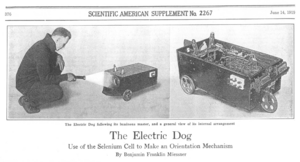Benjamin Miessner facts for kids
Quick facts for kids
Benjamin Franklin Miessner
|
|
|---|---|
| Born | July 27, 1890 Huntingburg, Indiana, U.S.
|
| Died | March 25, 1976 (aged 85) |
| Nationality | American |
| Occupation | Engineer and Inventor |
| Known for | Electrical music instruments aircraft radios |
| Awards | De Forest Audion gold medal Distinguished Service Award from the Boys Club of America |
Benjamin Franklin Miessner (born July 27, 1890 – died March 25, 1976) was an American engineer and inventor. He is famous for creating electronic musical instruments. These included the electronic organ and piano. He also invented the "cat's whisker" detector, which helped early radios work.
Contents
Early Life and Cool Inventions
Miessner was born in Huntingburg, Indiana. His parents were Charles and Mary Miessner. He was also the brother of Otto Miessner. He finished high school in Huntingburg in 1908.
Then, he joined the U. S. Navy. In 1909, he graduated from the U.S. Naval Electrical School in Brooklyn, New York. He became a radio operator at a naval station in Washington, D.C.. While there, he invented the "cat's whisker" detector. This invention helped crystal radios pick up radio waves. He was also promoted to Chief Operator.
In 1911, he left the Navy. He began working with John Hays Hammond Jr. and Fritz Lowenstein. This team worked on a wireless control system for torpedoes. Miessner also invented a superheterodyne radio system while working for Hammond. The group also created the "Electric Dog." This prop showed how light changes how electricity moves through a material called selenium.
Miessner left Hammond's company in 1912. From 1913 to 1916, he studied electrical engineering at Purdue University. He was part of the Sigma Pi fraternity. He also talked with Nikola Tesla about radio controls. Miessner was writing a book about radio dynamics.
In June 1916, he married Eleanor M. Schulz in Buffalo, New York. They had two daughters, Jane and Mary. That same year, he rejoined the Navy. He became an Expert Radio Aid for Aviation. He developed radio systems for airplanes. He also published his book, “Radiodynamics, the wireless control of torpedoes and other mechanisms”. During World War I, he worked at the Navy Aeronautic Station in Pensacola, Florida. He was in charge of their radio laboratory.
After World War I, he worked for Emil J. Simon in New York City. They made radios for aircraft and long-distance receivers. In the early 1920s, he moved to Chicago. There, he worked for the Brunswick-Balke-Collender Company. He started their sound laboratory. In 1926, he moved back to New Jersey. He became the chief engineer at Garod Corp.
Miessner Inventions, Inc.
In the late 1920s, Miessner sold over 50 of his patents to RCA. He received about $750,000 for them. He used this money to start his own company. It was called Miessner Inventions, Inc. and was in Millburn, New Jersey.
For the next 30 years, he became a leader in many fields. These included:
- Electronic musical instruments
- Radio receivers
- Sound recording
- Directional microphones for aircraft and submarines
- Other electronic devices
He also improved the Wurlitzer organ and electronic piano.
In 1929, he published his second book, All-electric Radio Receiver Design. In 1936, he wrote a long article. It was about electronic music and instruments. This article was published in the Proceedings of the Institute of Radio Engineers.
In the early 1930s, he worked with his brother, Otto. They tried to invent an instrument called a rhythmicon. However, Léon Theremin had already made a similar instrument with the same name.
In 1934, one of Miessner's patents was used by the Everett Piano Company. This led to the first large-scale production of an electronic organ. It was known as the Orgatron. In 1954, the Rudolph Wurlitzer Company used his 1935 design. This design was for an amplified piano. It became the basis for their very successful Wurlitzer Electric Piano.
In 1937, Miessner designed an electric violin and cello. He had a legal dispute with another company over the violin's design. He lost this case.
Miessner closed his company in 1959. By then, he had been granted over 200 patents. He had sold about 150 of them. Most of his patents were about electronics, sound, and music. But some were different. For example, he invented ways to adjust the string tension on a tennis racket. He also invented a non-leaking fountain pen.
Later Years and Awards
After closing his company, Miessner stayed busy. He continued writing and working. In 1962, he published an article about radio beams. In 1963, he wrote about the challenges of inventing.
In 1963, he was appointed to a special panel. This panel worked on reforming the patent system. It was part of the U.S. Department of Commerce. In 1964, he published his third book. It was called On the Early History of Radio Guidance.
He was also a board member of the Academy of Applied Sciences. He was president of the Patent Equity Association. He was a member of several groups, including:
- The Acoustical Society of America
- The American Physics Society
- The Veteran Wireless Operators Association
He also kept inventing and filing for new patents.
In 1963, Miessner won the De Forest Audion gold medal. This award was for his inventive achievements. In 1964, he received the Distinguished Service Award. This award came from the Boys Club of America.
Miessner passed away at his home in Miami, Florida.
Images for kids
-
The Electric Dog as shown in Scientific American



